吴恩达《机器学习》编程作业——machine-learning-ex1:线性回归
❄❄❄❄❄❄❄❄【回到目录】❄❄❄❄❄❄❄❄
本次编程作业中,需要完成的代码有如下几部分:
[⋆] warmUpExercise.m - Simple example function in Octave/MATLAB
[⋆] plotData.m - Function to display the dataset
[⋆] computeCost.m - Function to compute the cost of linear regression
[⋆] gradientDescent.m - Function to run gradient descent
[†] computeCostMulti.m - Cost function for multiple variables
[†] gradientDescentMulti.m - Gradient descent for multiple variables
[†] featureNormalize.m - Function to normalize features
[†] normalEqn.m - Function to compute the normal equations
1 warmUpExercise.m --- Octave/MATLAB的简单函数
在文件warmUpExercise.m中,您将看到Octave / MATLAB函数的概要。通过填写以下代码修改它以返回5 x 5单位矩阵:
function A = warmUpExercise() %WARMUPEXERCISE Example function in octave % A = WARMUPEXERCISE() is an example function that returns the 5x5 identity matrix % ============= YOUR CODE HERE ==============
A = eye(5);
% ========================================== end
完成之后,运行ex1.m,就可以看到类似于以下内容的输出:
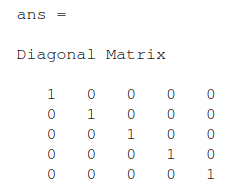
2 plotData.m --- 将数据绘制成图像
绘制图形可以帮助我们可视化数据。对于此数据集,我们可以使用散点图来绘制数据,因为它只有收益和人口两个数据(在现实生活中很多问题都是多维数据表示,并不能绘制成二维图)。
加载数据:
data = load('ex1data1.txt');
X = data(:, 1); y = data(:, 2);
m = length(y); % number of training examples
接下来,该程序调用plotData子函数来绘制数据的散点图。 你的工作是完成plotData.m函数来绘制图像;,修改代码:
function plotData(x, y)
% ====================== YOUR CODE HERE ======================
% Hint: 您可以在绘图中使用'rx'选项,使标记显示为红色十字。
% 此外,您可以使用plot(...,'rx','MarkerSize',10)
% 使标记更大
figure; % 打开一个新的数字窗口
plot(x, y, 'rx','MarkerSize', 10); %r代表red; x 代表十字标记 ;10是标记的大小
ylabel('Profit in $10,000s'); %加y轴的标签
xlabel('Population of City in 10,000s');
% ============================================================
end
运行ex1.m之后,你可以看到Figure 1。
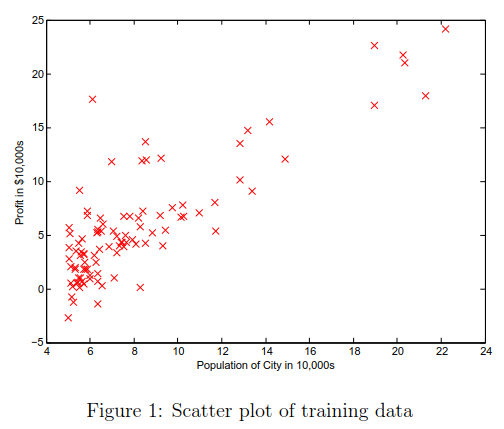
3 computeCost.m --- 计算代价函数
线性回归的目的就是最小化代价函数:

其中假设函数hθ(x)是一个线性模型:hθ(x) = θT x = θ0 + θ1x1。
当您执行梯度下降从而最小化成本函数J(θ)时,通过计算成本cost有助于监视是否收敛。 在本节中,您将实现一个计算J(θ)的函数,以便检查梯度下降实现的收敛性。
function J = computeCost(X, y, theta) %COMPUTECOST Compute cost for linear regression % J = COMPUTECOST(X, y, theta) computes the cost of using theta as the % parameter for linear regression to fit the data points in X and y % Initialize some useful values m = length(y); % number of training examples % You need to return the following variables correctly % ====================== YOUR CODE HERE ====================== % Instructions: Compute the cost of a particular choice of theta % You should set J to the cost. J = (1/(2*m))*sum(((X*theta) - y).^2) % ========================================================================= end
完成该子程序后,ex1.m中将使用零初始化的 θ 运行computeCost,您将该结果:

4 gradientDescent.m --- 运行梯度下降
接下来你的任务是完成gradientDescent.m,从而实现梯度下降。在编程时,请确保你了解要优化的内容和正在更新的内容。 请记住,代价函数J(θ)参数 θ 的函数,而不是X和y。 也就是说,我们通过改变参数θ的值而不是通过改变X或y来最小化J(θ)。验证梯度下降是否正常工作的一种好方法是查看J(θ)的值,并检查它是否随着每一次迭代减小。 如果正确实现了梯度下降和computeCost,则J(θ)的值不应该增加,并且应该在算法结束时收敛到稳定值。
我们通过调整参数 θ 的值从而最小化代价函数 J(θ)。通过batch梯度下降可以达到目的。在梯度下降中,每次迭代都执行下面的这个更新:

function [theta, J_history] = gradientDescent(X, y, theta, alpha, num_iters)
%GRADIENTDESCENT Performs gradient descent to learn theta
% theta = GRADIENTDESCENT(X, y, theta, alpha, num_iters) updates theta by
% taking num_iters gradient steps with learning rate alpha
% Initialize some useful values
m = length(y); % number of training examples
J_history = zeros(num_iters, 1);
for iter = 1:num_iters
% ====================== YOUR CODE HERE ======================
% Instructions: Perform a single gradient step on the parameter vector
% theta.
%
% Hint: While debugging, it can be useful to print out the values
% of the cost function (computeCost) and gradient here.
%
theta = theta-alpha*(1/m)*X'*(X*theta)-y);
% ============================================================
% Save the cost J in every iteration
J_history(iter) = computeCost(X, y, theta);
end
end
当你完成之后, 完成后,ex1.m将使用最终参数来绘制线性逼近。 结果应如下图所示:
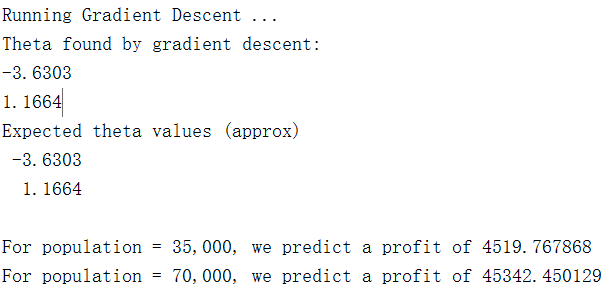
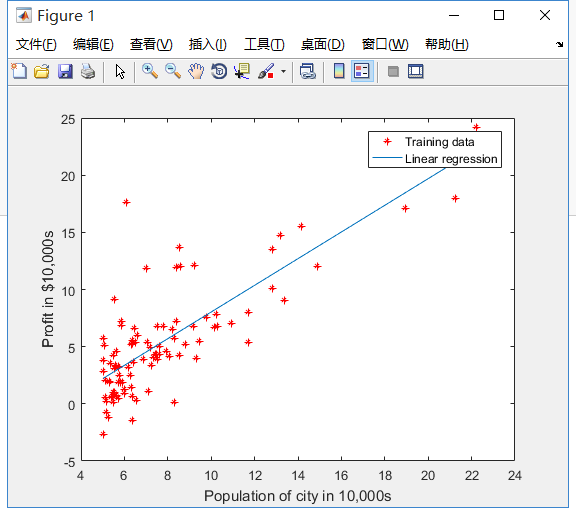
5 featureNormalize.m --- 特征缩放
数据中,房屋大小的数量级约为卧室数量的1000倍。 当特征相差几个数量级时,首先执行特征缩放可以使梯度下降更快地收敛。特征缩放的方式有以下几种:【特征缩放】(4.3节)
你的任务是完成featureNormalize.m
function [X_norm, mu, sigma] = featureNormalize(X) %FEATURENORMALIZE Normalizes the features in X % FEATURENORMALIZE(X) returns a normalized version of X where % the mean value of each feature is 0 and the standard deviation % is 1. This is often a good preprocessing step to do when % working with learning algorithms. % You need to set these values correctly X_norm = X; mu = zeros(1, size(X, 2)); sigma = zeros(1, size(X, 2)); % ====================== YOUR CODE HERE ====================== % Instructions: First, for each feature dimension, compute the mean % of the feature and subtract it from the dataset, % storing the mean value in mu. Next, compute the % standard deviation of each feature and divide % each feature by it's standard deviation, storing % the standard deviation in sigma. % % Note that X is a matrix where each column is a % feature and each row is an example. You need % to perform the normalization separately for % each feature. % % Hint: You might find the 'mean' and 'std' functions useful. % mu = mean(X_norm); sigma = std(X_norm ); X_norm(:,1) = ((X_norm(:,1)-mu(1)))./sigma(1); X_norm(:,2) = ((X_norm(:,2)-mu(2)))./sigma(2); % ============================================================ end
6 computeCostMulti.m --- 计算多变量的代价函数
之前已经完成了单变量线性回归中的计算代价函数和梯度下降,多变量的和单变量基本一致,唯一不同的是数据X矩阵中多了一个特征。
注意:在多变量的情况下,代价函数也可以使用以下的向量化形式编写:(向量化形式会使得计算更加高效)
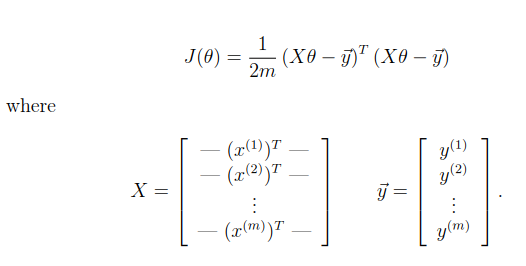
function J = computeCostMulti(X, y, theta) %COMPUTECOSTMULTI Compute cost for linear regression with multiple variables % J = COMPUTECOSTMULTI(X, y, theta) computes the cost of using theta as the % parameter for linear regression to fit the data points in X and y % Initialize some useful values m = length(y); % number of training examples % You need to return the following variables correctly J = 0; % ====================== YOUR CODE HERE ====================== % Instructions: Compute the cost of a particular choice of theta % You should set J to the cost. J = (X*theta-y)'*(X*theta-y); %或者 J = (1/(2*m))*sum(((X*theta) - y).^2); % ========================================================================= end
7 gradientDescentMulti.m --- 多变量的梯度下降
function [theta, J_history] = gradientDescentMulti(X, y, theta, alpha, num_iters)
%GRADIENTDESCENTMULTI Performs gradient descent to learn theta
% theta = GRADIENTDESCENTMULTI(x, y, theta, alpha, num_iters) updates theta by
% taking num_iters gradient steps with learning rate alpha
% Initialize some useful values
m = length(y); % number of training examples
J_history = zeros(num_iters, 1);
for iter = 1:num_iters
% ====================== YOUR CODE HERE ======================
% Instructions: Perform a single gradient step on the parameter vector
% theta.
%
% Hint: While debugging, it can be useful to print out the values
% of the cost function (computeCostMulti) and gradient here.
%
theta = theta - (alpha/m)*(X')*(X*theta - y);
% ============================================================
% Save the cost J in every iteration
J_history(iter) = computeCostMulti(X, y, theta);
end
end
8 normalEqn.m --- 正规方程
区别于迭代的方式,还可以用正规方程来求解:

使用此公式不需要任何特征缩放,可以在一次计算中得到一个精确的解决方案。
function [theta] = normalEqn(X, y) %NORMALEQN Computes the closed-form solution to linear regression % NORMALEQN(X,y) computes the closed-form solution to linear % regression using the normal equations. theta = zeros(size(X, 2), 1); % ====================== YOUR CODE HERE ====================== % Instructions: Complete the code to compute the closed form solution % to linear regression and put the result in theta. % % ---------------------- Sample Solution ---------------------- theta = pinv(X'*X)*(X'*y) % ------------------------------------------------------------- % ============================================================ end
如果这篇文章帮助到了你,或者你有任何问题,欢迎扫码关注微信公众号:一刻AI 在后台留言即可,让我们一起学习一起进步!

吴恩达《机器学习》编程作业——machine-learning-ex1:线性回归的更多相关文章
- coursera吴恩达 机器学习编程作业原文件 及我的作业
保存在github上供广大网友下载:点击 8个zip,原文件,没有任何改动. 另外,不定期上传我自己关于这门课的学习过程笔记和心得,有兴趣的盆友可以点击这里查看.
- 【吴恩达课后编程作业】第二周作业 - Logistic回归-识别猫的图片
1.问题描述 有209张图片作为训练集,50张图片作为测试集,图片中有的是猫的图片,有的不是.每张图片的像素大小为64*64 吴恩达并没有把原始的图片提供给我们 而是把这两个图片集转换成两个.h5文件 ...
- ML:吴恩达 机器学习 课程笔记(Week1~2)
吴恩达(Andrew Ng)机器学习课程:课程主页 由于博客编辑器有些不顺手,所有的课程笔记将全部以手写照片形式上传.有机会将在之后上传课程中各个ML算法实现的Octave版本. Linear Reg ...
- 用纯Python实现循环神经网络RNN向前传播过程(吴恩达DeepLearning.ai作业)
Google TensorFlow程序员点赞的文章! 前言 目录: - 向量表示以及它的维度 - rnn cell - rnn 向前传播 重点关注: - 如何把数据向量化的,它们的维度是怎么来的 ...
- Machine Learning——吴恩达机器学习笔记(酷
[1] ML Introduction a. supervised learning & unsupervised learning 监督学习:从给定的训练数据集中学习出一个函数(模型参数), ...
- Machine Learning|Andrew Ng|Coursera 吴恩达机器学习笔记
Week1: Machine Learning: A computer program is said to learn from experience E with respect to some ...
- Coursera-AndrewNg(吴恩达)机器学习笔记——第二周编程作业
一.准备工作 从网站上将编程作业要求下载解压后,在Octave中使用cd命令将搜索目录移动到编程作业所在目录,然后使用ls命令检查是否移动正确.如: 提交作业:提交时候需要使用自己的登录邮箱和提交令牌 ...
- Coursera-AndrewNg(吴恩达)机器学习笔记——第二周编程作业(线性回归)
一.准备工作 从网站上将编程作业要求下载解压后,在Octave中使用cd命令将搜索目录移动到编程作业所在目录,然后使用ls命令检查是否移动正确.如: 提交作业:提交时候需要使用自己的登录邮箱和提交令牌 ...
- Machine Learning|Andrew Ng|Coursera 吴恩达机器学习笔记(完结)
Week 1: Machine Learning: A computer program is said to learn from experience E with respect to some ...
- ML:吴恩达 机器学习 课程笔记(Week5~6)
Neural Networks: Learning Advice for Applying Machine Learning Machine Learning System Design
随机推荐
- 浅谈css3有意思的属性pointer-events: none;
pointer-events: none: 可以让某个元素实现类似于海市蜃楼的效果,具体理解为,你可以看的到某个元素,但是你无法摸的着. 而display:none; 是你摸不着,但是你也看不见. ...
- mybatis 一对多查询
需求:一条数据对应多张表 ad_share_friends 主表 ad_share_image 图片表 建立实体 adShareFriends 和 adShareImage *注意在adShar ...
- JEECG BOOT
JEECGBOOT - 开源搜索 - 开源中国https://www.oschina.net/search?scope=blog&q=JEECGBOOT JEECG 基于代码生成器J2EE智能 ...
- Appium环境搭建-完整版
环境依赖 Node.js Appium Appium-desktop Appium-doctor Appium-Python-Client Python JDK Andriod SDK 以上所需的软件 ...
- ubuntu下python跑任务输出到文件中遇到的一些问题(输出重定向)
之前主要是参考https://www.cnblogs.com/chason95/articles/9760291.html 一般使用 python test.py > ./log.txt 或 p ...
- [ffmpeg] 滤波格式协商
ffmpeg的中滤波器是以帧为原料来进行滤波的,那么自然地就会对帧的格式有所要求,可以说如果滤波器不知道帧的格式,就无法对帧进行处理.在进行视频滤波时,滤波格式指的是视频的像素格式:在进行音频滤波时, ...
- Debian社区群龙无首
导读 前两天有过消息 Debian 包维护者 Michael Stapelberg 因对 Debian 社区的现状不满而宣布退出 Debian 的维护,该消息引发了人们对于 Debian 的担忧.11 ...
- 曝Wi-Fi重大缺陷:你浏览的或是个假网站
今年央视315晚会上曝光的Wi-Fi探针收集用户信息的热度还未消退,阿里安全专家研究发现了Wi-Fi的重大新问题:基于WPA/WPA2设计上存在的一些缺陷,用户在使用公共Wi-Fi时,被攻击者钓鱼,进 ...
- PHP7 中 ?? 与? :的区别
??是PHP7版本的新特性,它与?:的区别在哪里呢 ?? $b = $a?? $c ;相当于$b= isset($a)?$a:$c; ?: $b = $a?$a: $c 则是 $b = !empty( ...
- Java Web乱码原因与解决
Java Web乱码原因与解决 一.了解编码常识: 1.ASCII 码 众所周知,这是最简单的编码.它总共可以表示128个字符,0~31是控制字符如换行.回车.删 除等,32~126是打印字符,可以通 ...
